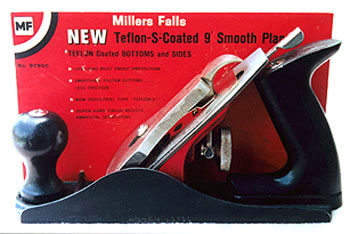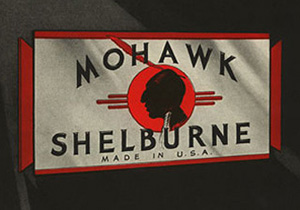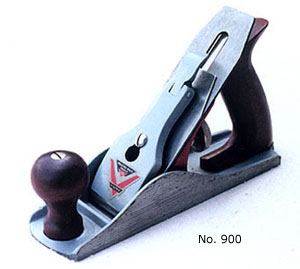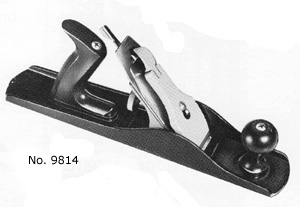Mid-line, Teflon & Economy Bench Planes
Mid-line models 90 and 140
 In 1958, the Millers Falls Company brought out an intermediate-grade jack plane and smoother. The Model 90 smooth plane and Model 140 jack were equipped with several features lacking in the economy models. The most significant were that the bottoms of the planes were milled, rather than sanded, and that the lever caps were equipped with tensioning springs. At a time when the firm’s economy models featured industrial gray lever caps and beds, the mid-line planes sported attractive black bodies and nickel-plated caps. The flashier appearance aside, the general fit and finish of the mid-line models was closer to that of the economy planes than that of the premium models.
In 1958, the Millers Falls Company brought out an intermediate-grade jack plane and smoother. The Model 90 smooth plane and Model 140 jack were equipped with several features lacking in the economy models. The most significant were that the bottoms of the planes were milled, rather than sanded, and that the lever caps were equipped with tensioning springs. At a time when the firm’s economy models featured industrial gray lever caps and beds, the mid-line planes sported attractive black bodies and nickel-plated caps. The flashier appearance aside, the general fit and finish of the mid-line models was closer to that of the economy planes than that of the premium models.
The manufacturer’s markings and model numbers on the No. 90 and 140 planes were applied, rather than permanently affixed. This allowed the basic tools to be easily re-branded for sale by the large hardware retailers.
The model 90 and 140 hand planes were discontinued in 1968. Versions with corrugated bottoms were manufactured under contract for the United States government.
Mid-line teflon-coated models 9140 and 9790
 Pictured left is the company’s teflon-coated smooth plane with the dealer’s display card attached. In 1969, Millers Falls introduced a short-lived series of planes featuring beds with teflon coating on the sides and soles. Three models were produced: the No. 9140 jack plane, the No. 9790 smooth plane and the No. 9775 block plane. The No. 9140 replaced the No. 140 jack plane, the No. 9790, the No. 90 smoother. The tools were equipped with black-painted beds and handles. The frogs were painted red and the lever caps nickel plated.
Pictured left is the company’s teflon-coated smooth plane with the dealer’s display card attached. In 1969, Millers Falls introduced a short-lived series of planes featuring beds with teflon coating on the sides and soles. Three models were produced: the No. 9140 jack plane, the No. 9790 smooth plane and the No. 9775 block plane. The No. 9140 replaced the No. 140 jack plane, the No. 9790, the No. 90 smoother. The tools were equipped with black-painted beds and handles. The frogs were painted red and the lever caps nickel plated.
The company used Dupont’s industrial quality Teflon-S on the planes. At the time, the chemical firm was promoting the coating to tool manufacturers, and Stanley, as well as Millers Falls, took an interest in the new substance. The tool manufacturers were intrigued by teflon’s rust protection and friction reduction features. Stanley tried the coating on several of its saws; the Millers Falls Company’s major effort involved the three hand planes. Promotional material for the planes promised “lifelong rust protection” and a “super hard finish” that “...resists abrasion, scratching.”
As anyone who has gone through the serial replacement of teflon-coated pots and pans can attest, the term abrasion resistant does not mean abrasion proof. Consumers were hesitant that the coating would stand up to the abuse that tools are given. Experience soon showed them to be correct, and the planes were discontinued in 1971.
Mohawk-Shelburne nos. 900 and 814 economy planes
 In 1931, Millers Falls introduced a line of low priced, economy grade tools under the Mohawk-Shelburne brand name. Geared to the occasional user, costs were minimized through the use of less expensive materials and production methods. The bench planes in the line consisted of a smoothing and a jack plane—model numbers 900 and 814 respectively.
In 1931, Millers Falls introduced a line of low priced, economy grade tools under the Mohawk-Shelburne brand name. Geared to the occasional user, costs were minimized through the use of less expensive materials and production methods. The bench planes in the line consisted of a smoothing and a jack plane—model numbers 900 and 814 respectively.
Both planes were designed with black-painted hardwood handles and one-piece lever caps. The clamping levers on the caps were painted red. The cutters used in these planes were described as being of “good quality” rather than “tool steel” (the term used to describe the cutters of the top of the line planes).
Mohawk-Shelburne planes first appeared in the 1935 catalog. By the time that the October 1949 catalog was published, the Mohawk-Shelburne line of economy tools was no longer The No. 900 and the No. 814 continued to be sold, however, under the Millers Falls trade name.
Millers Falls nos. 900 and 814 economy planes
 When Millers Falls discontinued its second quality Mohawk-Shelburne line, it continued to market the No. 900 and No. 814 economy planes under the Millers Falls brand name. Some minor changes in appearance were made. The clamping levers on the lever caps were no longer being painted red—the entire cap was painted black. In addition, the cutters were now described as being made from tool steel rather than “good quality steel.” This second change, though more than cosmetic, was more likely due to the dropping cost of quality steel than to a desire to reposition the planes in the marketplace.
When Millers Falls discontinued its second quality Mohawk-Shelburne line, it continued to market the No. 900 and No. 814 economy planes under the Millers Falls brand name. Some minor changes in appearance were made. The clamping levers on the lever caps were no longer being painted red—the entire cap was painted black. In addition, the cutters were now described as being made from tool steel rather than “good quality steel.” This second change, though more than cosmetic, was more likely due to the dropping cost of quality steel than to a desire to reposition the planes in the marketplace.
Pictured at right is an example of the No. 900 as it appeared in the latter 1950s. In 1956, Millers Falls introduced its V-Line models, a series of tools marketed to price-conscious home owners. Sometimes referred to as the Value Line, the V-Line tools were identified by decals featuring a bright red letter V. In general, the company opted to create a new look for existing products rather than develop new models for the new line. Gray and red paint and burgundy-stained wooden parts became hallmarks of this series of tools. In addition to the No. 900 smoothing plane, the No. 814 jack bench plane was designated as a V-Line product. The company stopped using the V-Line trade mark in 1960. Shortly before the demise of the V-Line, the color of the handles and frogs on the Millers Falls No. 900 and 814 planes reverted to the original black.
The manufacturer’s markings and model numbers on most No. 900 and 814 planes were applied, rather than permanently affixed. This method of identification allowed the tools to be easily re-branded for sale by the large hardware retailers. Planes sold as Millers Falls products were typically identified by decals on the lever cap or by incised markings on the tote. A smaller number of Millers Falls-branded economy planes bore no model numbers of any sort or were identified with the stamping on the left cheek typical of that used for the premium models.
Nos. 8900 and 9814 economy planes

In 1974, the models 900 and 814 became the 8900 and 9814. Under the new numbers, the two popularly priced economy planes were offered through at least 1984—eight years after the last premium bench plane had disappeared from the catalog. Neither the sides nor the bottoms of the planes were milled. Catalog copy indicates that only the bottoms of the planes were polished.
Although the company offered a premium bench plane until 1976, it had been apparent since the late 1960s that the mass market for quality hand planes had collapsed. The Millers Falls economy planes were deemed adequate to meet the needs of a public that had become increasingly unaware of the capabilities of a fine hand tool.